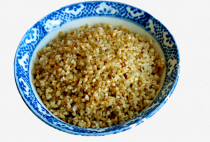Ashley Etheredge's Science & Society Food Benchmark Q1
Kasha Recipe By Julia Boyer & Ashley Etheredge

Ingredients
Preparing Kasha
Instructions
My Food Rule Slide
Ingredients
- 1 egg
- 2 cups of veggie/chicken broth
- 1 tbsp. butter
- 1 cup of Buckwheat/ Kasha
- Cumin
- Jane’s Krazy mixed-up Seasonings (original)
Preparing Kasha
Instructions
- Step 1: Get a large pot, pour broth and bring to a boil, mix in a tbsp. of butter.
- Step 2: Meanwhile, mix Kasha and egg together.
- Step 3: Put Kasha and egg mixture into the wok/ frying pan on medium heat.
- Step 4: Stir continuously (so that the kasha mixture will not stick to the pan or together), let the grains separate and looks dry but not brown.
- Step 5: When broth comes to a boil, pour into wok/frying pan.
- Step 6: Stir and cover on medium heat for 30 minutes (check every 5-10 minutes to stir), let the Kasha absorb the broth.
- Step 7: When the Kasha has absorbed all of the broth, season to taste with mixed seasoning salt and cumin.
This meal is an easy and healthy option for any family. It consists of two
whole ingredients and two processed ingredients. As a staple food in Eastern
Europe, Kasha is filling and nutritious. It is 82% carbohydrates, 12% protein and
6% fats. Kasha is also a good source of dietary fiber and magnesium with 155
calories for 168 grams. The dietary fiber is the part of food that your body cannot
process; therefore it acts as a regulator for your digestive system. Magnesium is
important for numerous functions in your body: nerve impulse transmissions and
formation of healthy bones. It’s safe to say that this food is nutritious. It is also an
environmentally friendly dish.
The buckwheat used was organic and the eggs were from free-range
chickens. The store we purchased these items from look for local farms to buy from
so the buckwheat groats and eggs didn’t travel far. The item that traveled the
farthest was the vegetable broth that we wanted to use to be vegetarian. It was
imported from Canada and creates a large carbon footprint, which is ironic and an
example of the choices and priorities consumers have.
The cost of a meal is a big deciding factor for consumers. This meal is fairly
feasible. The entire buckwheat costs only 3 dollars and this recipe calls for half of
the bag. One organic egg costs 32 cents and the broth costs around 3 dollars. While
the total is much more than a fast food meal, this is a pretty cheap meal considering
that two of the items, if not more are organic.
An important aspect of kasha is that most of these products can be produced
through a self-sufficient process. Chickens can make the eggs and are easy to
contain as livestock in backyards. Buckwheat is apparently easy to grow and can be
used in numerous types of food. The only issue with the self-sufficient food process
is the limited resources in certain urban areas. Ashley and I are fortunate to own
houses with backyards, but many people live in apartments or row homes and
cannot grow their own food. However, many of these items were purchased in Acme
and were still labeled “organic” so this meal could still be accessible.
Therefore, Kasha is a good food to know how to cook. It is nutritious,
environmentally friendly and affordable. All of the items needed for Kasha can be
bought at grocery markets such as Acme or local stores or even grown at home. As a
dish, Kasha follows a lot of the food rules. It is less than 5 ingredients, it is something
my grandmother would recognize as food, and it’s vegetarian and organic. All in all,
it’s a great dish.
Personal Reflection
I’ve learned a lot about my role in the food system in this unit as well as the role that the food system plays in our lives. In the documentary, Food inc, I got to see just how close knit our government is to each other. I also was able to see how terrible our conventional food system is, because they deliberately keep Americans in the dark about what they’re eating because they want people to want to buy their food. But if McDonalds was as small as a local restaurant that had an e-coli breakout, it would be immediately shut down so that no one goes there to eat again.But when it’s a multi-million dollar company in which more people are at risk of getting food poisoning, they continue to produce possibly poisoned food. The biggest problem in our system is not that the American’s are in the dark, although that is a very, very large problem the biggest problem is that the people we Americans trust to protect us have no power against these companies, so it’s hard to tell what we can or can’t eat especially if the ones we should eat are not available to us (because they’re too expensive or not sold at the grocery stores we can afford). What helped me recognize my role in the system was to spread the word about conventional food operations and the bad things that can happen to people if they are not careful about what they eat. Personally, I’m going to tell my family and change how we eat and where we buy our fruits and vegetables from.
My Food Rule Slide

Comments
No comments have been posted yet.
Log in to post a comment.